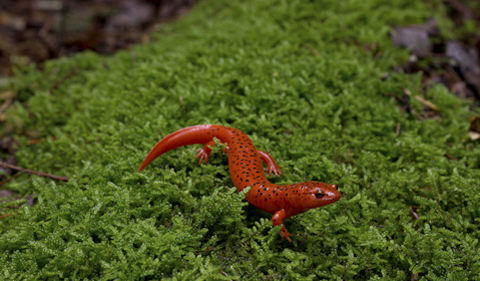By Natalia Radic
From Perspectives
Hiking through the trails of Appalachia, Biological Sciences doctoral student Vincent Farallo focuses his attention on the ground, under the leaf litter, in search of small, colorful lungless salamanders.
These amphibians live in “microhabitats” of only 1-10 meters squared. Because they breathe through their skin, they must live in an environment that provides cool air and moist soil to survive.
These factors make the lungless salamanders a good case study for how climate change in Appalachia could impact the smallest of species, says Farallo, a fourth-year doctoral student advised by Dr. Donald Miles, Professor of Biological Sciences.
“Salamanders can be abundant and make up a large portion of forest floor biomass,” Farallo says. “So any changes to them would affect the overall forest dynamics. In particular, it will change leaf litter decomposition rates through changes in insect communities.”
With the help of undergraduate students Celeste Wheeler and William Ternes, Farallo conducted a population survey of lungless salamanders in the Appalachian Mountains during summer 2013. The team started in the Great Smokey Mountains National Park in North Carolina, and continued through Tennessee and Virginia, up through West Virginia, and back to North Carolina.
Farallo’s work was supported by several Ohio University grants and fellowships, including the Graduate College Fellowship, the Student Enhancement Award, and the Ohio Center for Ecology and Evolutionary Studies Fellowship. He’s also received funds from the American Philosophical Society Lewis and Clark Fund.
For the study, Farallo categorized sites as high, medium, and low elevation and by latitude, as well as by high or low species concentration. The students recorded data such as vegetation and soil and air temperature, as well as soil moisture. The same data was collected 10 meters away at control sites where there were no salamanders, to help Farallo determine how the amphibians choose their habitats.
Farallo now has recorded more than 60 sites throughout North Carolina, Tennessee, West Virginia, Virginia, and Ohio. Although he’ll continue to collect data for two more years to reach conclusive results, he’s made some important observations so far.
“There were many sites that, after hours of searching, didn’t have any salamanders,” Farallo says, “although they should have.”
This story appears in the Spring/Summer 2014 issue of Ohio University’s Perspectives magazine, which covers research, scholarship and creative activity.





















Comments